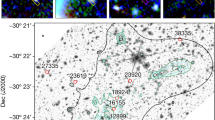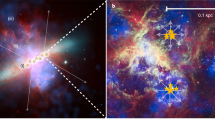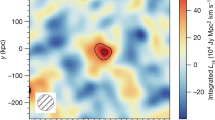Abstract
A large number of faint galaxies, born less than a billion years after the Big Bang, have recently been discovered1,2,3,4,5,6. Fluctuations in the distribution of these galaxies contributed to a scatter in the ionization fraction of cosmic hydrogen on scales of tens of megaparsecs, as observed along the lines of sight to the earliest known quasars7,8,9. Theoretical simulations predict that the formation of dwarf galaxies should have been suppressed after cosmic hydrogen was reionized10,11,12,13, leading to a drop in the cosmic star-formation rate14. Here we report evidence for this suppression. We show that the post-reionization galaxies that produced most of the ionizing radiation at a redshift z ≈ 5.5 must have had a mass in excess of ∼1010.9 ± 0.5 solar masses (M⊙) or else the aforementioned scatter would have been smaller than observed. This limiting mass is two orders of magnitude larger than the galaxy mass that is thought to have dominated the reionization of cosmic hydrogen (∼108M⊙). We predict that future surveys with space-based infrared telescopes will detect a population of smaller galaxies that reionized the Universe at an earlier time, before the epoch of dwarf galaxy suppression.
This is a preview of subscription content, access via your institution
Access options
Subscribe to this journal
Receive 51 print issues and online access
$199.00 per year
only $3.90 per issue
Buy this article
- Purchase on Springer Link
- Instant access to full article PDF
Prices may be subject to local taxes which are calculated during checkout

Similar content being viewed by others
References
Rhoads, J. E. & Malhotra, S. Lyα emitters at z = 5.7. Astrophys. J. Lett. 563, 5–8 (2001)
Shimasaku, K. et al. Subaru Deep Survey. IV. Discovery of a large-scale structure at redshift ∼5. Astrophys. J. Lett. 586, 111–114 (2003)
Bouwens, R. J. et al. Galaxies at z = 7–8: z850-dropouts in the Hubble Ultra Deep Field. Astrophys. J. Lett. 616, 79–82 (2004)
Bouwens, R. J., Illingworth, G. D., Blakeslee, J. P. & Franx, M. Galaxies at z∼6: The rest-frame UV luminosity function and luminosity density from 506 UDF, UDF-PS, and goods I-dropouts. Preprint at http://arXiv.org/astro-ph/0509641 (2005).
Ouchi, M. et al. Subaru Deep Survey. VI. A census of Lyman break galaxies at z = 4 and 5 in the Subaru deep fields: Clustering properties. Astrophys. J. 611, 685–702 (2004)
Stark, D. P. & Ellis, M. Searching for the sources responsible for cosmic reionization: Probing the redshift range 7 < z < 10 and beyond. Preprint at http://arXiv.org/astro-ph/0508123 (2005).
Djorgovski, S. G. in Proc. Tenth Marcel Grossmann Meeting on General Relativity (eds Novello, M., Perez-Bergliaffa, S. & Ruffini, R.) (World Scientific, Singapore, in the press); preprint at http://arXiv.org/astro-ph/0409378 (2004)
Djorgovski, S. G., Bogosavljevic, M. & Mahabal, A. Quasars as probes of late reionization and early structure formation. New Astron. Rev. 50, 140–145 (2006)
Fan, X. et al. Constraining the evolution of the ionizing background and the epoch of reionization with z∼6 quasars. II: Analysis using a sample of 19 quasars. Preprint at http://arXiv.org/astro-ph/0512082 (2005).
Efstathiou, G. Suppressing the formation of dwarf galaxies via photoionization. Mon. Not. R. Astron. Soc. 256, 43–47 (1992)
Quinn, T., Katz, N. & Efstathiou, G. Photoionization and the formation of dwarf galaxies. Mon. Not. R. Astron. Soc. 278, L49–L54 (1996)
Thoul, A. A. & Weinberg, D. H. Hydrodynamic simulations of galaxy formation. II. Photoionization and the formation of low-mass galaxies. Astrophys. J. 465, 608–616 (1996)
Dijkstra, M., Haiman, Z., Rees, M. J. & Weinberg, D. H. Photoionization feedback in low-mass galaxies at high redshift. Astrophys. J. 601, 666–675 (2004)
Barkana, R. & Loeb, A. Identifying the reionization redshift from the cosmic star formation rate. Astrophys. J. 539, 20–25 (2000)
Fan, X. et al. A survey of z > 5.7 quasars in the Sloan Digital Sky Survey III: Discovery of five additional quasars. Astron. J. (in the press); preprint at http://arXiv.org/astro-ph/0405138 (2005)
Pentericci, L. et al. VLT optical and near-infrared observations of the z = 6.28 quasar SDSS J1030 + 0524. Astron. J. 123, 2151–2158 (2002)
White, R. L., Becker, R. H., Fan, X. & Strauss, M. A. Probing the ionization state of the Universe at z > 6. Astron. J. 126, 1–14 (2003)
Wyithe, J. S. B. & Loeb, A. A large neutral fraction of cosmic hydrogen a billion years after the Big Bang. Nature 427, 815–817 (2004)
Rhoads, J. E. et al. Spectroscopic confirmation of three redshift z = 5.7 Lyα emitters from the large-area Lyman alpha survey. Astron. J. 125, 1006–1013 (2003)
Bunker, A., Stanway, E., Ellis, R. & McMahon, R. G. The star formation rate of the Universe at z∼6 from the Hubble Ultra-Deep Field. Mon. Not. R. Astron. Soc. 355, 374–384 (2004)
Ellis, R., Santos, M., Kneib, J.-P. & Kuijken, K. A faint star-forming system viewed through the lensing cluster Abell 2218: First light at z∼5.6? Astrophys. J. Lett. 560, 119–122 (2001)
Santos, M., Ellis, R., Kneib, J.-P., Richard, J. & Kuijken, K. The abundance of low-luminosity Lyα emitter at high redshift. Astrophys. J. 606, 683–701 (2004)
Kneib, J.-P., Ellis, R. S., Santos, M. R. & Richard, J. A probable z∼7 galaxy strongly lensed by the rich cluster A2218: Exploring the Dark Ages. Astrophys. J. 607, 697–703 (2004)
Loeb, A., Barkana, R. & Hernquist, L. Was the Universe reionized at redshift 10? Astrophys. J. 620, 553–558 (2005)
Sheth, R. K., Mo, H. J. & Tormen, G. Ellipsoidal collapse and an improved model for the number and spatial distribution of dark matter haloes. Mon. Not. R. Astron. Soc. 323, 1–12 (2001)
Leitherer, C. et al. Starburst99: Synthesis models for galaxies with active star formation. Astrophys. J. Suppl. 123, 3–40 (1999)
Wyithe, J. S. B. & Loeb, A. Cosmic variance in the transparency of the intergalactic medium after reionization. Preprint at http://arXiv.org/astro-ph/0508604 (2006).
Barkana, R. & Loeb, A. Unusually large fluctuations in the statistics of galaxy formation at high redshift. Astrophys. J. 609, 474–481 (2004)
Lidz, A., Oh, S. P. & Furlanetto, S. R. Have we detected patchy reionization in quasar spectra? Astrophys. J. Lett. 639, 47–50 (2006)
Barkana, R. & Loeb, A. Effective screening due to minihalos during the epoch of reionization. Astrophys. J. 578, 1–11 (2002)
Dekel, A. & Woo, J. Feedback and the fundamental line of low-luminosity low-surface-brightness/dwarf galaxies. Mon. Not. R. Astron. Soc. 344, 1131–1144 (2003)
Kauffmann, G. et al. The dependence of star formation history and internal structure on stellar mass for 105 low-redshift galaxies. Mon. Not. R. Astron. Soc. 341, 54–69 (2003)
Spergel, D. N. et al. Three-year Wilkinson Microwave Anisotropy Probe (WMAP) observations: Implications for cosmology. Astrophys. J. (submitted); preprint at http://lambda.gsfc.nasa.gov/product/ map/dr2/pub_papers/threeyear/ parameters/wmap_3yr_param.pdf (2006).
Acknowledgements
This work was supported in part by grants from ARC, NSF and NASA. We acknowledge helpful discussions with A. Lidz regarding this work.
Author information
Authors and Affiliations
Corresponding authors
Ethics declarations
Competing interests
Reprints and permissions information is available at npg.nature.com/reprintsandpermissions. The authors declare no competing financial interests.
Supplementary information
Supplementary Discussion
The Letter to Nature with the above title interprets the observed luminosity function of z~6 galaxies and the large-scale fluctuations in the Lyman-alpha optical depth towards z~6 quasars, based on a detailed theoretical model. This supplement provides full details on the basic version of this model as well as its variants. (PDF 620 kb)
Rights and permissions
About this article
Cite this article
Wyithe, J., Loeb, A. Suppression of dwarf galaxy formation by cosmic reionization. Nature 441, 322–324 (2006). https://doi.org/10.1038/nature04748
Received:
Accepted:
Issue Date:
DOI: https://doi.org/10.1038/nature04748
This article is cited by
-
A common mass scale for satellite galaxies of the Milky Way
Nature (2008)
-
Astrophysics in 2006
Space Science Reviews (2007)
Comments
By submitting a comment you agree to abide by our Terms and Community Guidelines. If you find something abusive or that does not comply with our terms or guidelines please flag it as inappropriate.



